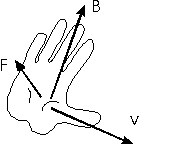The right-hand rule
The magnitude of the force felt by a charge q moving with velocity v through a magnetic field B is:
![]()
As stated previously, the direction of the force is perpendicular to both v and B. One more thing must be said to define the direction. For example, if both v and B point in the plane of the screen, F could point either into or out of the screen to be perpendicular to both vectors. The flat right-hand rule is used to determine which of these two directions for F is the correct one.

To find the direction of
F,
This version of the right hand rule applies directly to finding the direction
of the force on a segment of wire carrying a current
I. It also works to find the direction of the
force on a moving charge; you only have to realize that for a positive
charge I points in the direction of
v, while for a negative charge,
v is opposite to
I.